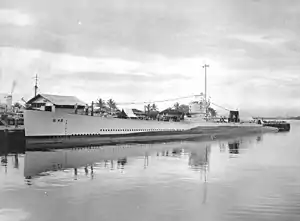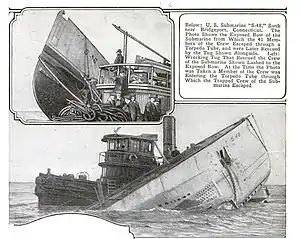 | |
| History | |
|---|---|
| Name | USS S-48 |
| Builder |
|
| Laid down | 22 October 1920 |
| Launched | 26 February 1921 |
| Sponsored by | Mrs. James O. Germaine |
| Commissioned | 14 October 1922 |
| Decommissioned | 7 July 1925 |
| Recommissioned | 8 December 1928 |
| Decommissioned | 16 September 1935 |
| Recommissioned | 10 December 1940 |
| Decommissioned | 29 August 1945 |
| Stricken | 17 September 1945 |
| Fate | Sold for scrapping 22 January 1946 |
| General characteristics | |
| Class and type | S-class submarine |
| Displacement |
|
| Length | 240 ft (73 m) |
| Beam | 21 ft 10 in (6.65 m) |
| Draft | 13 ft 6 in (4.11 m) |
| Speed |
|
| Complement | 38 officers and men |
| Armament |
|
| Service record | |
| Operations: | World War II |
USS S-48 (SS-159) was the first submarine in the fourth group of S-class submarines of the United States Navy.
S-48 was one of only five submarines — along with USS S-14 (SS-119), USS S-15 (SS-120), USS S-16 (SS-121). and USS S-17 (SS-122) — built by the Lake Torpedo Boat Company to see service in World War II. She was the second-to-last of them to be decommissioned.
Construction and commissioning
S-48's keel was laid down on 22 October 1920 by the Lake Torpedo Boat Company in Bridgeport, Connecticut. She was launched on 26 February 1921, sponsored by Mrs. James O. Germaine.
1921 diving accident

On 7 December 1921, the still-uncommissioned submarine conducted a dive off Penfield Reef in Long Island Sound as part of builder's trials. A manhole plate in one of the aft ballast tanks was left unsecured, several aft compartments flooded, and S-48 sank in 80 feet (24 meters) of water.[1] The crew, contractor's personnel, and naval observers brought the bow to the surface and escaped through a torpedo tube to a tug which took them to New York City.[1]
On 20 December 1921, the submarine was raised and taken back to the builder's yard, where repairs were begun. The work was completed ten months later.
Service history
1st commission, 1922–1925
On 14 October 1922, S-48 was accepted by the Navy and commissioned the same day at Bridgeport. Following commissioning, S-48 fitted out at the New York Navy Yard; visited Peekskill, New York, for Navy Day; returned to Bridgeport, and, at the end of October, arrived at her home port, New London, Connecticut. Two weeks later, she was towed to the Portsmouth Naval Shipyard in Kittery, Maine, for further yard work; and, in late January 1923, she returned to New London to commence operations with her division, Submarine Division 4 (SubDiv 4). Through May, she operated in the New London area; then, in early June, she moved south for sound exercises and a visit to Washington, DC. At mid-month, she returned to southern New England; and, in August, she proceeded back to Portsmouth for the installation of new crankshafts and a general ship and machinery overhaul period.
In mid-January 1924, S-48 departed Portsmouth for New London, whence she continued south, to the Caribbean Sea, for winter maneuvers. By mid-March 1924, however, she was back at Portsmouth for another five months of yard work. In early August 1924, she resumed operations in the New London area, and, in November 1924, after being transferred to SubDiv 2, she visited Annapolis, Maryland. In December 1924, she returned to Connecticut, and, toward the end of January 1925, she headed back to Portsmouth.
On the night of 29 January 1925, S-48 arrived off the New Hampshire coast. At about 18:30, the wind picked up and a heavy snowstorm developed. Visibility was reduced to zero. Soon after 19:34, the S-boat grounded on rocks off Jeffrey Point; pulled herself off; then grounded again in Little Harbor. Messages requesting assistance were dispatched. By midnight, the storm had worsened, seas were coming "clean [sic] over the S-48" and she was rolling – 15 degrees to port, 60 degrees to starboard. Violent rolling lasted for only a little over thirty minutes but a heavy list developed. By 03:30 on 30 January, the battery compartment was taking in water. Chlorine gas was forming. The storm continued; but help arrived at 05:00, and Coast Guardsmen manning lifeboats rescued the crew. After receiving treatment for exposure and gas at Fort Stark, crew members were transferred to the Portsmouth Navy Yard in Kittery, Maine.
On 1 February 1925, salvage operations were begun. A week later, the S-boat was freed and towed to the navy yard for repairs. However, the damage was severe and the funds were lacking; and, on 7 July 1925, S-48 was decommissioned. Nearly a year later, though, on 25 June 1926, repairs and alterations were authorized, and, on 3 February 1927, the work began. Three Boston & Maine locomotives, G-Class Switchers numbered 426, 413, & 222 respectively, were first used to haul the submarine into a boathouse at the Portsmouth Naval Shipyard in Kittery, Maine, where work on mending her hull could begin.[2] But, again, a shortage of funds stopped the project. In 1928, the repair and modernization was carried out. In hopes of improving habitability and increasing her range, her hull was extended 25½ feet; her displacement was increased to 1165 tons, and her engines were replaced by German M.A.N. types. On 1 December 1928, the work was finally completed. On 8 December 1928, almost four years after her accident, S-48 was recommissioned.
2nd commission, 1929–1935
Assigned to SubDiv 12, she departed Portsmouth on 11 January 1929 and headed south. After operations off southern Florida on the Navy-Princeton gravity expedition to the West Indies (February–March 1932), she returned to New London in March 1929 and, in April 1929, commenced a series of test exercises. A casualty to the main motor, however, forced postponement of the exercises, and S-48 returned to Portsmouth. On 5 June 1929, she resumed the exercises.
On 1 June 1929, S-48 had been reassigned to SubDiv 4, with which she operated through the end of 1929. Then assigned to SubDiv 3, later SubDiv 5, and then Squadron 3, she continued her operations off the New England coast, with an interruption for winter maneuvers to the south. During this time, Lieutenant Hyman G. Rickover was assigned to her. He later credited S-48's "faulty, sooty, dangerous and repellent engineering" with inspiring his obsession for high engineering standards.[3] She was transferred to the Panama Canal Zone in 1931. On 1 March, she arrived at Coco Solo, whence she operated for four years.
The 1932 Navy-Princeton gravity expedition to the West Indies
The first gravity measurements at sea had been made in 1926 from a submarine of the Royal Navy. The first U.S. gravity measurements at sea had been made from the submarine USS S-21 (SS-126), assisted by the Eagle Boats USS Eagle No. 35[4] and USS Eagle No. 58.[5][6] S-48 was assigned at the request of the Hydrographer of the Navy by the Secretary of the Navy to assist with the second U.S. expedition to obtain gravity measurements at sea using a gravimeter, or gravity meter, designed by Dr. Felix Vening Meinesz. Meinesz, joined by Dr. Harry Hammond Hess of Princeton University, and a U.S. Navy technician, participated in the expedition.[3] The submarine was accompanied and assisted by the minesweeper USS Chewink (AM-39) in a route from Guantanamo Bay, Cuba to Key West, Florida and return to Guantanamo through the Bahamas and Turks and Caicos region from 5 February through 25 March 1932. The description of operations and results of the expedition were published by the U.S. Navy Hydrographic Office in The Navy-Princeton gravity expedition to the West Indies in 1932.[7]
In July 1933, S-48 was assigned to the Rotating Reserve; and, in 1935 she was ordered inactivated. On 20 March 1935, she departed Coco Solo. On 1 June 1935, she arrived at Philadelphia, Pennsylvania; and, on 16 September 1935, she was decommissioned and berthed at League Island.
3rd commission, 1940–1945
On 1 September 1939, World War II broke out in Europe. In 1940, S-48 was ordered activated. She was recommissioned on 10 December 1940, but remained at Philadelphia until mid-March 1941. She then moved up to her home port of New London, Connecticut.
As a unit of Submarine Squadron One (SubRon 1), she provided services to submarine and antisubmarine warfare training commands at New London and Portland, Maine, until after the end of European hostilities in early May 1945. Overhaul and repair periods during that time were frequent; and, in the summer of 1945, the World War I-design submarine was finally designated for disposal.
Fate
On 21 August 1945, S-48 departed New London for the last time and was decommissioned at Philadelphia on 29 August 1945. On 17 September 1945, her name was struck from the Naval Vessel Register, and on 22 January 1946 her hulk was sold to the North American Smelting Company in Philadelphia for scrapping.
Awards
References
This article incorporates text from the public domain Dictionary of American Naval Fighting Ships. The entry can be found here.
- 1 2 "Submarine Casualties Booklet". U.S. Naval Submarine School. 1966. Archived from the original on 27 July 2011. Retrieved 8 September 2009.
{{cite web}}: CS1 maint: unfit URL (link) - ↑ The Day the Boston & Maine Joined the Navy, retrieved 18 June 2022
- 1 2 Duncan, Francis (2012). Rickover: The Struggle for Excellence. Naval Institute Press. ISBN 978-1591142218.
- ↑ "navsource.org Eagle Boat 35". Archived from the original on 6 July 2008. Retrieved 16 December 2009.
- ↑ "navsource.org Eagle Boat 58". Archived from the original on 9 July 2008. Retrieved 16 December 2009.
- ↑ Pinsel, Mark I. (1982). 150 Years Of Service On The Seas - A Pictorial History of the U.S. Naval Oceanographic Office from 1830 to 1980. Washington, D.C.: U. S. Government Printing Office. p. 233. Chapter 4-Gravity at Sea
- ↑ http://siris-libraries.si.edu/ipac20/ipac.jsp?uri=full=3100001~!210409!0 Archived 23 February 2012 at the Wayback Machine | The Navy-Princeton gravity expedition to the West Indies in 1932